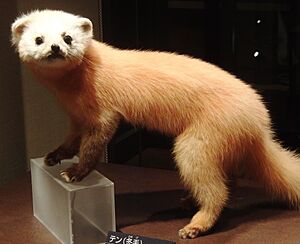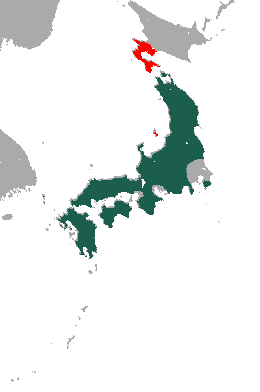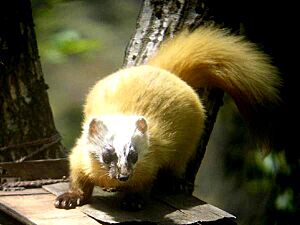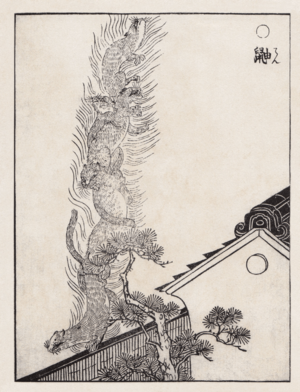Japanese marten facts for kids
Quick facts for kids Japanese marten |
|
|---|---|
 |
|
| A stuffed specimen exhibited in the National Museum of Nature and Science, Tokyo | |
| Conservation status | |
| Scientific classification | |
| Genus: |
Martes
|
| Species: |
melampus
|
 |
|
| Japanese marten range | |
| Synonyms | |
|
Crocutictis melampus |
|
The Japanese marten (its scientific name is Martes melampus) is a type of marten. It lives only in Japan.
Contents
About the Japanese Marten
Japanese martens are about 0.5 meters (1.6 feet) long. Their tail adds another 20 centimeters (7.9 inches). They weigh between 1 and 1.5 kilograms (2.2 to 3.3 pounds). Male martens are usually bigger than females. Their fur can be dark brown to dull yellow. They often have a cream-colored throat.
What Japanese Martens Eat and How They Behave
Both male and female martens protect their own areas. The size of their territory depends on how much food is available. Japanese martens eat many different things. They prefer meat from fish, frogs, and small birds or mammals. But if needed, they will also eat insects, fruit, and seeds.
Where Japanese Martens Live
There are two types of Japanese martens:
- M. m. melampus lives on many of the Japanese islands.
- M. m. tsuensis lives only on Tsushima Island.
The Japanese marten is closely related to the sable. Sables also live in some of the same areas, like Hokkaido.
Japanese martens were brought to Hokkaido and Sado Island by people. They have been seen in South Korea. However, no one has proven that they live there in the wild.
Japanese Marten Reproduction and Life Cycle
Japanese martens have their babies between March and mid-May. They usually have one baby, called a kit. But they can have up to five kits at a time. When they are born, the kits cannot see or hear.
Like other mammals, the mother marten feeds her young with milk. By 3 to 4 months old, the kits can hunt on their own. They soon leave their mother. Martens can have their own babies when they are 1 to 2 years old. We don't know how long they live in the wild. But one marten in a zoo lived for over 12 years.
After growing up, young martens often try to find their own territory. They use their scent to mark their area.
Where Japanese Martens Make Their Homes
Japanese martens live in boreal forests across much of mainland Japan. In winter, martens often go to forests where they can find the most prey. They like older, well-established forests. This is because the animals they hunt have adapted to these places. Martens also live a long time. So, they can help us understand how healthy a forest is. In summer, their diet and habitat become more flexible. This allows them to live in many different environments.
Japanese Martens and Nature
One important job martens do in nature is spreading seeds. Many fruits rely on birds and bats to spread their seeds. But in colder places, there are fewer birds and bats. This means fewer seeds get spread. In these areas, meat-eating animals that also eat plants, like the Japanese marten, can help. They are good at spreading seeds because they travel over large areas. This helps seeds get far from the parent plant. Also, martens are bigger than birds or bats. So, they can carry and spread larger seeds. About 62% of Japanese marten droppings contain seeds.
How Japanese Martens Affect People
Japanese martens can have both good and bad effects on people. On the good side, they hunt Japanese hares. These hares can damage trees by eating them. However, martens also eat many insects that help with farming.
Threats to Japanese Martens and What's Being Done
The biggest danger to the Japanese marten is the logging industry. This industry cuts down the old forests that martens prefer. Often, they clear-cut forests quickly. This destroys the martens' homes without letting the forest grow back. This practice also makes marten groups isolated. This changes how they find food and reduces their genetic diversity. Also, pine plantations in their habitats do not have enough food for martens.
People are working to protect martens. The most common way is by making rules about trapping them. In 1971, the species was named a Natural Monument Species in Japan. This brought attention to how vulnerable the species is. The species also has legal protection on Tsushima Island.
Japanese Martens in Legends
In the Iga region of Mie Prefecture, there's a saying: "the fox has seven disguises, the tanuki has eight, and the marten has nine." This legend says that martens are better at changing their shape than foxes (kitsune) or tanuki.
In Akita Prefecture and Ishikawa Prefecture, if a marten crosses your path, it's thought to be a sign of bad luck. (Weasels have a similar legend.) In Hiroshima Prefecture, if you kill a marten, people say you will soon have a fire. In Fukushima Prefecture, martens are also called heko, fuchikari, komono, and haya. People there believe they are people who died in avalanches, now in disguise.
In a collection of yōkai (Japanese spirits or monsters) pictures called Gazu Hyakki Yagyō by Sekien Toriyama, martens were shown under the title "鼬". This word was read as "ten", not "itachi". "Ten" are weasels that have lived for many years and become yōkai with special powers. In the picture, several martens are gathered above a ladder. They create a column of fire. People feared that if martens gathered like this near a house, the house would catch fire.




